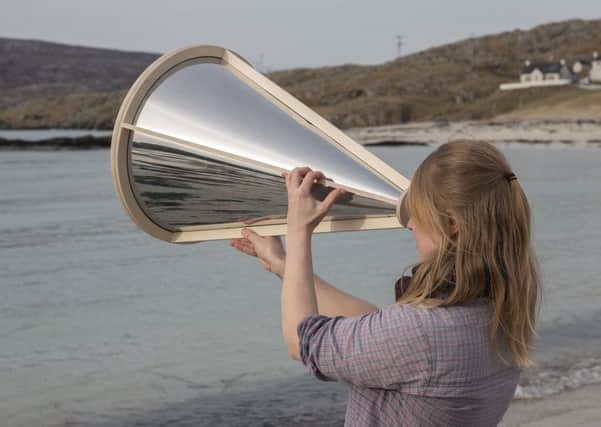Art review: Contemporary Connections at Summerhall, Edinburgh


Contemporary Connections ***
Summerhall, Edinburgh
Certainly Contemporary Connections, a group of shows at Summerhall for the Edinburgh Science Festival, seems to indicate a desire for a rapprochement, and on both sides perhaps for many of the artists have enjoyed science residencies and their approaches to the science and art problem depend on close collaboration between the two sides. The results don’t seem yet to offer any very profound insights, however.
From the Dark Ocean Comes Light, for instance, is a show by Hannah Imlach created over a year spent with the Institute of Biological Chemistry at Heriot Watt University and the Changing Oceans Group at Edinburgh University. In this company, she has witnessed research on coral and on marine fluorescence in the deep waters to the west of Scotland.
Advertisement
Hide AdAdvertisement
Hide AdExamples of the art she has produced include circular transparencies viewed through a mirrored cone. It is a kind of lateral kaleidoscope intended to simulate the deep sea environment. More interesting visually is a projection through a water lens, a sphere half filled with water, which appears to suggest the behaviour of fluorescent molecules.
Sebastian Verea’s Sounds of the Anthropocene combines a huge and rather chilling graphic display of the impact of human activity on the globe over a given period of years and its translation into sound. The changing graphics chart population growth, plastic pollution of the sea, plutonium residues, carbon on the atmosphere etc. The outcome is terrifying. Since 1930 all these various measurements have gone from virtually nought to levels of global peril. This work is also the result of a collaboration between the artist and academic institutions. In this case the University of Cambridge and the Universidad Internaçional de San Martin in Argentina.
Rubber Coated Steel by Lawrence Abu Hamdan portrays in text on a video screen extracts from the record of the trial in Israel after the shooting of Nadeem Nawara and Mohammed Abu Daher. The prosecution case included the argument that as Palestinian boys learnt to distinguish the sound of a rubber bullet being fired from that of live ammunition, the Israeli Army’s response was to disguise live ammunition as rubber bullets: rubber coated steel caused the deaths.
Louise Mackenzie’s Genophone is an extraordinary invention, or perhaps intervention. Somehow she has converted text into synthetic genetic material and spliced it into the DNA of bacteria. The words change and so do the bacteria. Is the eventual outcome living books or thought as biology? I am not sure, but it does seem fiendishly ingenious.
In all this arty science, however, I particularly enjoyed Steve Hurrel’s Beneath and Beyond Seismic Sounds, recordings of the world’s grumbling tummy, at least that is what it sounds like. He has brought together recordings, or real time transmissions, it is not clear which, from seismic recording stations round the world. Their readings are magnified and translated into the gastric rumbles, creaks and groans of our long-suffering and put-upon planet.
Team Shrub is a collaboration between artists Simon Sloan, Archie Crofton and Jeff Kirkby and unnamed scientists and communicators at Edinburgh University. The result is Exploring the Art in Data. The input includes data relating to climate change in the Arctic. Although visually intriguing, the outcome appears to be no more than abstract film.
I was also intrigued by what I could see of Lily Hubberd’s Black Hole Horizon, the product of a Heriot Watt residency. The main part of her show seemed to be in a black hole of its own behind a locked door to which nobody had the access code.
Advertisement
Hide AdAdvertisement
Hide AdPerhaps that was the metaphor, but what I did see presented some fascinating information about the behaviour of light as a fluid. Apparently recent discoveries reveal that in certain circumstances light can form a vortex which is exactly what black holes appear to be. Light can also be slowed down. Mind blowing stuff.
There are other shows as well. They are mostly more or less intriguing. Nevertheless, art like this is never going to find a wide public, so its role in the dissemination of new ideas is bound to be limited. Most of what it offers seems to be PR for science. Good PR indeed.
*Until 12 May